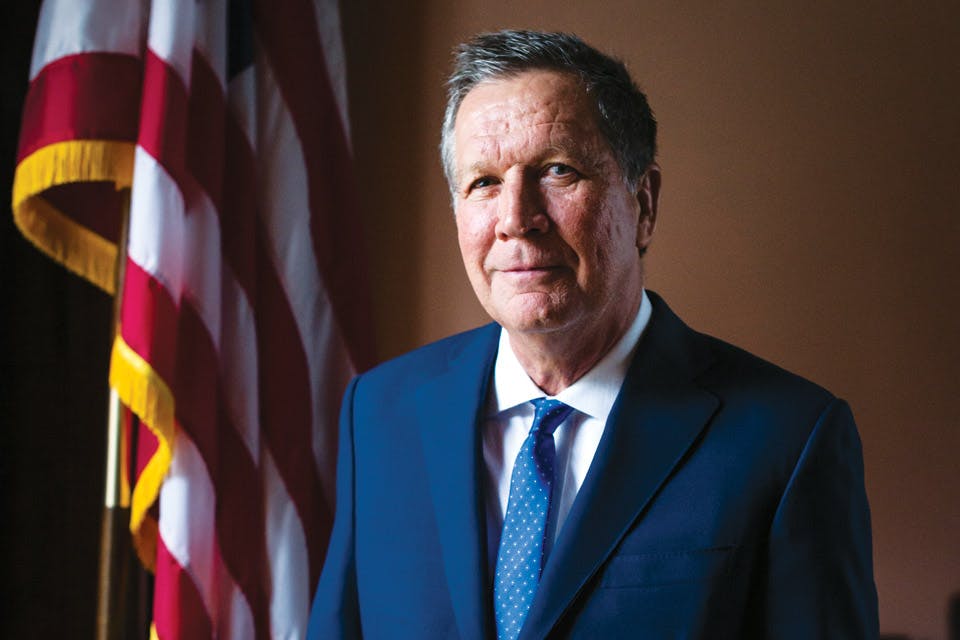Where Does John Kasich Go From Here?
We sit down with the governor to talk about leading Ohio, running for president and what’s next.
March 2018
BY Jim Vickers | Portrait by Angelo Merendino
March 2018
BY Jim Vickers | Portrait by Angelo Merendino
The Governor’s Office at the Ohio Statehouse looks much like it did when Abraham Lincoln visited in February 1861. The antique sofas and settees along the west wall are upholstered in the same red hue as the curtains that hug the windows, and a sturdy, synthetic replica of the room’s original wool carpeting covers the floor. It’s the sort of space where voices echo at the lowest of volumes and small decorative touches seem infused with elegance and purpose.
Near the center of the room rests a leather-topped rosewood and walnut desk that’s in remarkable shape given its age. During his 1861 visit, Lincoln was sitting here, discussing the impending war that would soon rip the nation apart with then Ohio Gov. William Dennison Jr., when he received word the U.S. House of Representatives had accepted the Electoral College’s vote confirming his election as president. The story goes that one of Lincoln’s hands was resting on the corner of the black leather desktop the moment he learned the news, a fact that begs visitors to reach out and touch the surface for themselves.
Gov. John Kasich often points out the desk to guests. Not long after his 2010 election, he renamed his Statehouse office the Lincoln Room in honor of the historic moment that took place there. These days, the governor’s staff works out of the 30th floor of the Riffe Center across the street, and Kasich’s Ohio Statehouse office is used for meetings, bill signings and other events. Today is one of those days.
It’s December, and Kasich is readying for an afternoon gathering of CEOs from more than a dozen of the state’s leading employers in the adjoining cabinet room. They’re visiting to discuss an issue Kasich has made a focus throughout his administration and into his last year in office: helping prepare tomorrow’s workers for the jobs of the future and making sure Ohio has a strong workforce that will draw innovators.
Three days earlier, the governor was on stage at The Ohio State University’s student union with L Brands founder, chairman and CEO Leslie Wexner and Eric Schmidt, then chairman of Google’s parent company, Alphabet.
Kasich talked about a “tsunami of possible job disruption in our country” with places like Ohio not having enough educated workers to fill the technology-ingrained jobs of the future. The mere potential of such a workforce crisis should trouble all Americans, particularly those who live in the Midwest.
“If what we’re thinking is true, when this tsunami of job loss comes, it will be very, very difficult for our society, and it could tear our society apart if we’re not giving people hope that they’re going to have something,” says Kasich, seated at the conference table in the Lincoln Room. “If you’re 53 years old and you lose your job and you can’t find another one, you lose hope. That’s not acceptable in our country.”
Kasich sees a solution in a revamp of our nation’s education system from kindergarten through college and beyond. The governor says workers need to be learning from their first day of preschool until the day they retire. It’s a big idea and one that Kasich knows will never happen without buy-in from political, business and education leaders.
The governor often talks about working together and common sense. He has throughout his career. It’s the message he delivered on a crowded stage as he sought the Republican nomination for president in 2016, but he got pre-empted by nicknames and noise.
Still, his decision to seek the nomination reintroduced Ohioans to Kasich and his straight-talk approach. The way he sees it, what has happened in our state during his two terms speaks for itself: balancing the state budget and erasing an $8 billion budget shortfall, attracting almost 500,000 new private sector jobs, leading an aggressive anti-drug effort, fixing a broken highway-funding system and increasing opportunities for Ohio’s most vulnerable citizens. He’s also continued to make his voice known on the national stage, in November 2017 calling for the need to address the epidemic of gun violence in the United States.
“We’ve been a very idea-based administration and we really govern without fear or consideration of politics and that’s, I think, made a difference for us,” Kasich says. “… We are most interested in solving problems.”
***
John Kasich has written four books, served nine terms in Congress, been elected governor twice and spent nearly nine months campaigning for the Republican nomination for president. That was the second time. Telling his story is helped by the fact he has already told so much of it himself.
He grew up in blue-collar, heavily Democratic McKees Rocks, Pennsylvania, the son of a mailman father and a postal clerk mother — parents who stressed to their three children to “do what you want to do — think big,” Kasich says. After graduation, he attended Ohio State University to study political science.
Then, just before Christmas during his freshman year, he had one of those moments that become part of a politician’s lore, one that for Kasich is preserved in a black and white photograph of the 18-year-old future governor confidently shaking hands with a smiling Richard Nixon in the Oval Office.
Earlier that semester, Kasich had learned Ohio State University president Novice Fawcett was meeting with Nixon and asked the college administrator to deliver a message to the White House for him. Fawcett agreed.
The three-page letter, which was published for the first time by the Dayton Daily News a few years ago, made it clear the future congressman and governor was available to meet whenever the president was: “I would immediately pass up a Rose Bowl trip to see you. My parents would permit me to fly down and see you anytime and I know my grades wouldn’t suffer.”
The governor doesn’t recall the contents of the letter, other than it was favorable, or what he and Nixon discussed during their 20 minutes together on Dec. 22, 1970. To Kasich, the subject doesn’t matter. It’s that he capitalized on the chance to meet the president, no matter how much of a long shot his letter was.
“Look, when you have an opportunity and there’s something you want to do, then you try to seize it,” Kasich says. “That’s the way I’ve always felt.”
In 1977, after working as an Ohio Senate intern and then administrative assistant to state Sen. Donald Lukens, Kasich began campaigning full time to defeat two-time 15th Senate District Democratic incumbent Robert E. O’Shaughnessy.
“I just thought I could do the job. That’s it,” the governor says, when asked what originally led him to run for office. “I thought I could do things better than the people I was looking at. I mean that’s how you have to decide if you’re going to run for office: Do you think you offer something more than the people who are there?”
Kasich’s youth, hunger and swagger fueled the race. One campaign handout — a flier with a photo of the candidate walking down the street, his suit jacket swung over his shoulder — asks “if you are shocked as to why Kasich’s opponent is so out of touch with the majority viewpoint, call him directly. He can be reached at his home (221-2311).” It didn’t even mention O’Shaughnessy by name.
Then, when Kasich tried to film a campaign commercial with two incumbent Republicans in the Ohio Senate chamber in August 1978, Ohio Senate clerk William H. Chavanne physically blocked them, citing a rule barring the room’s use for such a purpose. Kasich’s side argued a different rule. A judge agreed with the Republican challenger, and he filmed his commercial. He beat O’Shaugnessey that fall.
Today, the place where Kasich’s first day as a public official began is just a short walk upstairs from his Statehouse office. On a Monday in mid-December, we make it together. The governor swings open the wide wooden door and steps across the threshold of the ornate Ohio Senate chamber. He walks to the front of the room, stopping at the first row, at the spot immediately to the left of the aisle.
“So when I was here, I used to sit right here,” the governor says softly, almost reverently. “This was my seat.”
Kasich was 26 years old the day he took the oath of office in this room. Within three years, he’d be elected to the U.S. House of Representatives.
Westerville Public Library’s Local History Center is a trove of photos, old newspapers and artifacts that tell the Columbus suburb’s story. In the early 1900s, the town was the headquarters of the Anti-Saloon League, and a portion of the library’s history center is housed in the home where the temperance movement based its publishing efforts that helped bring on Prohibition.
The Local History Center is also home to the John R. Kasich Congressional Collection: more than five dozen carefully organized boxes of personal correspondence, handwritten notes, speeches, transcripts, daily schedules, financial documents, phone messages and more. Kasich, a longtime resident of Westerville, donated the collection to the library in 2004, along with his Congressional office desk and other artifacts from his time in Washington, including a small sign that reads: “It’s the national debt, stupid.”
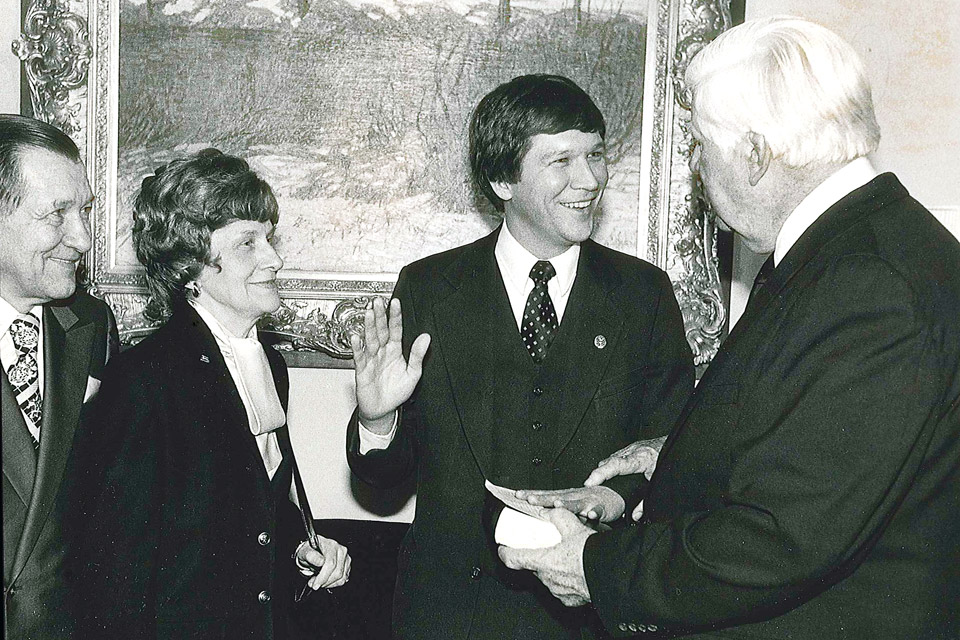
John Kasich’s parents, John and Anne, look on as their son takes the oath of office from Tip O’Neill in 1983. (photo courtesy of Westerville Public Library John R. Kasich Congressional Collection)
Going through the vast collection is a little like looking over Kasich’s shoulder during his Congressional years. There’s a handwritten note from Tim Russert following Kasich’s December 1994 appearance on “Meet The Press” (“Quite a program. The newspapers certainly paid attention,” the host scribbled inside.)
In another from 1990, then House Minority Whip Newt Gingrich writes to congratulate and urge on Kasich in his fight against the B-2 stealth bomber: “Be patiently optimistic in the B-2 but recognize it may have a long process ahead of it with the Senate, etc. Pleasant persistence is a key to your continued growth as your hard work pays off …” He signs off, “Keep it up. Your friend, Newt.”
Kasich served nine terms in the U.S. House after winning the Ohio 12th District seat in the fall of 1982. Within three months of coming to Congress, he was among the first Representatives to expose Pentagon overpayment for military spare parts.
He later led a successful bipartisan effort to stop the production of the B-2 stealth bomber, which carried a total program cost of up to $2 billion per aircraft. (The four-year effort ended the B-2’s production after 21 bombers instead of the 132 initially proposed.)
As chairman of the House Budget Committee between 1995 and 2000, Kasich chaired the House-Senate committee that wrote the welfare reform law of 1996. He was also chief architect of the Balanced Budget Act of 1997, which led to government budget surpluses annually between 1998 and 2001. It hasn’t happened since.
“What did I learn? Work with people, you know. Shoot high. Try to get things done,” Kasich says of his years in Congress. “The [balanced budget] hadn’t been done in a generation. So, it proves that you can accomplish things.”
Congressional years were also marked by tragedy and self-searching for Kasich. In 1987, his parents, John and Anne Kasich, where killed by a drunk driver, which led the lapsed Catholic to turn to God. He regularly attended a twice-monthly lunchtime Bible study with the same group of friends, which Kasich discussed in his third book, Every Other Monday: Twenty Years of Life, Lunch, Faith, and Friendship.
“It’s made me more concerned for those who tend to be ignored,” Kasich says, when asked of the role faith plays in his life.
“I don’t read the Bible to figure out how I’m going to make a decision in government,” he adds. “But, look, we are all in pursuit of, well, I shouldn’t say we all are ... I’m in pursuit of deeper faith, and I think the depth of it is hard for any one person to determine on a regular basis. It’s a work in progress.”
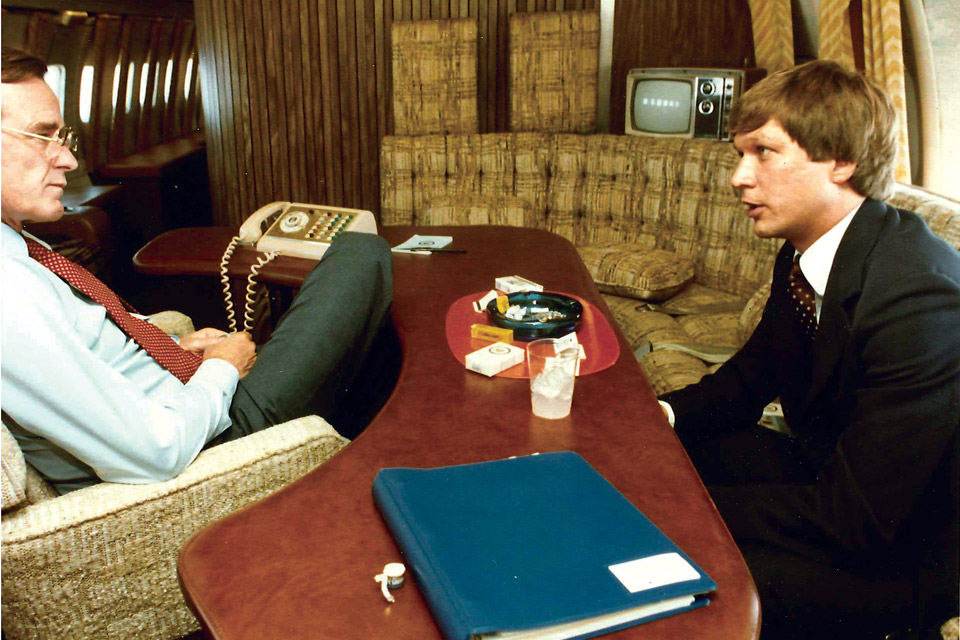
John Kasich meeting with President George H.W. Bush aboard Air Force One during the 1980s. (photo courtesy of Westerville Public Library John R. Kasich Congressional Collection)
In 1997, Kasich married Karen Waldbillig, and the couple had twin girls, Emma and Reese, three years later. He didn’t run for re-election to Congress, announcing in February 1999 he was launching an exploratory presidential campaign. It ended in mid-July, but 11 weeks before he bowed out, Kasich delivered a speech at the New Hampshire Republican State Committee’s “First In The Nation” dinner that summed up who he was and why he was running. A copy of the speech is archived in the Congressional Collection at the Westerville Public Library.
“I got into politics to change the world — to ease the frustrations of everyday working people,” his speech began. “I believe these frustrations develop from lack of control. They develop from events that not only frustrate us, but sap our spirits, damage our idealism and isolate us from one another.”
His speech asserts a “top-down government, dominated by elites” has “made us more cynical, more isolated and more polarized.” After outlining his vision — a focus on families and communities, school choice, Social Security reform, tax cuts and a belief that the solutions to our biggest problems lie within us — Kasich continued.
“People ask me all the time why I would want to run for president. Why do I keep coming to New Hampshire, when I could be home in Ohio? The answer is simple. I want to lead the mission to restore the American Dream.”
***
“I have no idea,” Kasich says, when asked what awaits him beyond Jan. 13, 2019, his last day in office as governor. It’s a question that’s been asked more and more in the two years since he beat Donald Trump in Ohio’s March 15, 2016, primary. Still, Kasich’s proven experience governing wasn’t enough to sway voters in other states.
So, how does one account for the fact that arguably the most experienced Republican candidate didn’t win the party’s nomination in 2016? It’s undoubtedly a question Kasich must have asked himself more than once in the past 24 months.
“I went to New Hampshire and beat everybody but Trump, but the whole media was fixated on Trump and so therefore I didn’t get the bump or the exposure that you would normally get in a situation like that,” Kasich says. “It was an odd year.”
On the campaign trail, he talked about the successes he’d had in Ohio and his record of Congressional leadership. It seemed like a winning combination. In past years, it probably would have been. But the large field of candidates and range of big personalities turned the Republican debates into weird, circus-like spectacles.
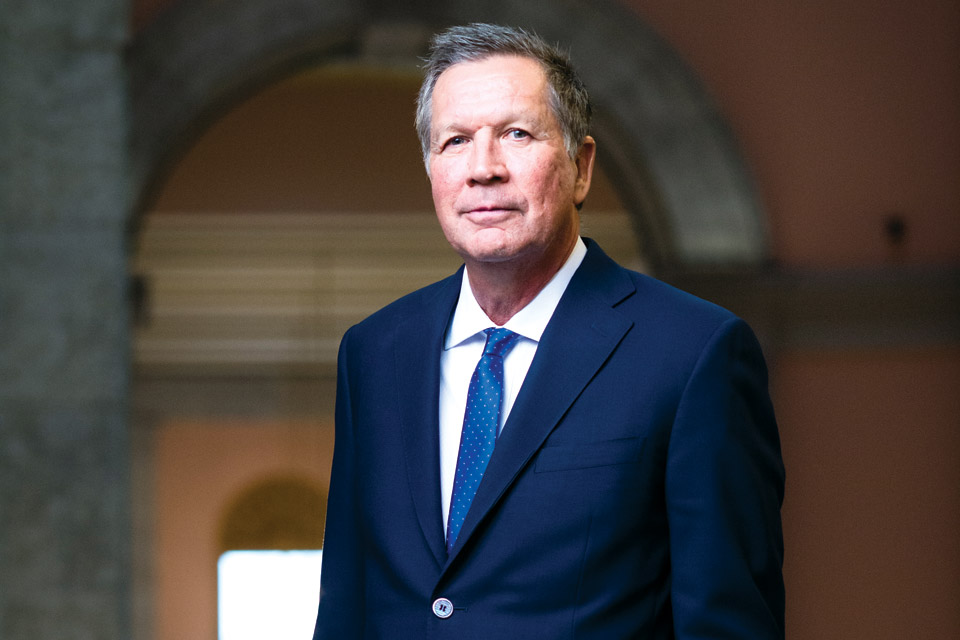
“It really isn’t up to me as to whether I keep my voice,” says Kasich. “It’s up to the people around me that want to help me to make sure I can be a voice of experience and good judgment. But if people decide they don’t want me to do that, then I won’t be doing it.” (photo by Angelo Merendino)
Because of Ohio’s term limits, Kasich can’t run for re-election, and those vying for the job — even his Lt. Gov. Mary Taylor — have made a point to draw a distinction between the popular two-term governor and themselves as they try to win over an electorate that helped put Donald Trump in the White House. When asked what advice he has for Ohio’s next governor, Kasich has a definitive answer that comes off as much as a challenge as it does wisdom.
“Well, to not be political and not be afraid, to continue to bring about change, because the Midwest’s greatest challenge is an aversion to risk.” Kasich says. “Don’t be a politician. Be a leader.”
Kasich spent nearly a decade out of politics between 2001 and 2010. Remember John Kasich, Fox News host? His “From the Heartland with John Kasich” ran from 2001 to 2007. “Longer than ‘Star Trek,’ ” Kasich points out, only half in jest. (He’s right about that, too. NBC canceled the sci-fi series after just three seasons in 1969.)
But any return to cable news would be to a much different political environment and entertainment landscape than the one he left a decade ago, and it doesn’t sound like Kasich finds the idea very appealing.
“When I was doing it, you tried to have both sides,” he says. “Now it’s come down to too much one way or the other. I don’t think that’s good. To me that’s not news. That’s political debate and political theater. Well, it’s not even debate. It’s political theater, because there is no debate.”
After his time in Congress, Kasich also spent seven years working as an investment banker at Lehman Brothers’ Columbus office. He took heat early in the 2016 presidential campaign for his association with the now-defunct firm, whose collapse helped spur the 2008 financial crisis. He fought back with a commercial explaining that he didn’t run Lehman Brothers; he worked in a two-person office in Columbus.
During the year he has left in office, the governor says he will remain focused on fostering an economic climate for job creation while leading the discussion on preparing Ohioans for the tech economy jobs of tomorrow. He knows it’s a big challenge and that his call for education reform is even bigger.
“And I frankly don’t know if it’s going to change,” Kasich says. “Because what it takes is leadership at all levels to recognize that people are going to be vulnerable to the digital changes that are coming in our economy. And our leaders — business leaders, politicians — are they willing to put the people in front of their own self interests, whether it’s profits, whether it’s votes? That’s the question.”
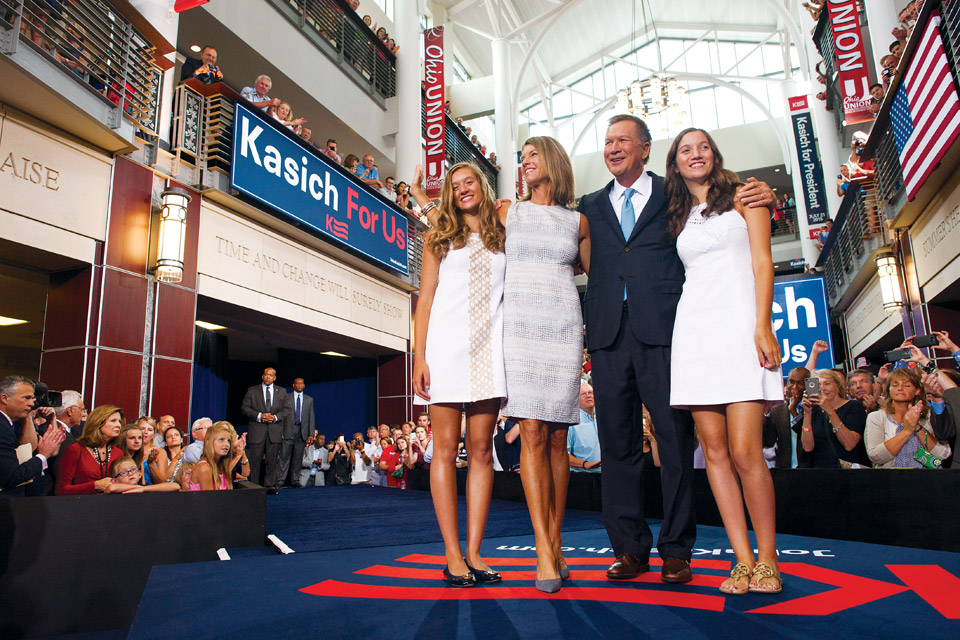
Gov. John Kasich stands with his wife, Karen, and daughters Emma (left) and Reese (right) after delivering the speech announcing his 2016 presidential candidacy at The Ohio State University student union in 2015 (photo by Ty Wright/Getty Images)
In November, Kasich penned an opinion piece about the issue of gun violence, a position that most Republicans tend to avoid, given how much the Second Amendment has been used as a rallying point. At the same time, Kasich says, “virtually everyone in the country knows” that gun violence is a big problem.
“I think we’ve lost our direction in that we sometimes see problems but we don’t want to deal with them because they might offend somebody,” he says, a few minutes later adding, “We need to come back to where people are putting their country or their city or their state or whatever ahead of what party they belong to.”
You may have noticed in recent weeks that John Kasich has been making the rounds again. In January, he appeared on Seth Meyers’ late-night NBC talk show. The same week, he sat down with Dan Rather. In some ways, it feels like Kasich has become a calming counterbalance to the fun-house mirror side of the political landscape that flows in from our televisions each evening. But, as he points out, his political future — much like his 2016 presidential fate — isn’t in his control.
“It really isn’t up to me as to whether I keep my voice,” says Kasich. “It’s up to the people around me that want to help me to make sure I can be a voice of experience and good judgment. But if people decide they don’t want me to do that, then I won’t be doing it. I don’t know what to say about that other than, I think I have something to contribute to the national debate, and I will.”
Related Articles

Two Ohioans Appear on the Hallmark Channel’s ‘Finding Mr. Christmas’
This holiday-themed reality show searches for the next Hallmark star, and Ohio natives Marcus Brodie and Logan Shepard are among the contestants this season. READ MORE >>

‘Ohio: Wild at Heart’ Now Showing in Select Theaters Statewide
Produced in partnership with the Ohio Department of Natural Resources, this film showcases some of our state’s most striking natural features. READ MORE >>

Historic Marker Installed at Home of Orville Wright
Hawthorn Hill, the Oakwood home where aviation pioneer Orville Wright lived with his sister and father, now bears a new marker celebrating its place in American history. READ MORE >>


